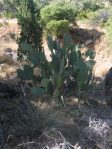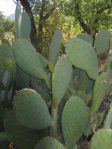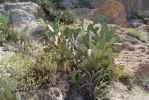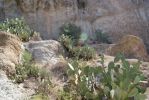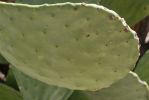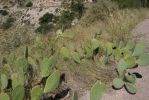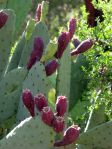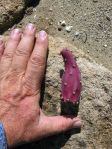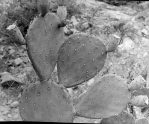
Coulter, Contributions from the U. S. National Herbarium 3: 419, 1896
Holotype; Isotype; Herbarium; Herbarium; Herbarium; Herbarium; Herbarium; Herbarium; Herbarium; Herbarium; Herbarium; Herbarium; Painting (Britton and Rose, v1 1919, plate XXVIII)
Original Description
What is Opuntia laevis?
Opuntia laevis is a sometimes spineless prickly pear cactus that grows in various locations in southern AZ but particularly on canyon walls or in the rubble below rather than canyon floors.
Details
O. laevis plants are naturally nearly spineless, or they may have a few short spines at the tips of cladodes or along the surface, but just a few. Cladodes on this prickly pear may be large, up to 10-12 cm wide and 30 cm long. They are often narrow proximally or may be elliptical, long-obovate, or sometimes obovate. Areoles are small, 3-4 mm long. Leaves are modestly recurved.
Flowers are yellow and tinged with red, about 6 cm broad. Stigmas are slender. The fruit is pyriform, 5-6(8) cm long and deeply umbilicate. The seeds are irregular and about 5 mm in diameter with a thick, undulate margin.
O. laevis may be diploid.
Other Notes
At one time, O. laevis was considered a variety of O. phaeacantha. More recently, a proposal has been made to place O. laevis as a variety of O. engelmannii. However, we continue to accept O. laevis as a stand-alone species. Because it is nearly spineless, it is sometimes misidentified in gardens as Burbank’s spineless cactus or even O. cacanapa ‘Ellisiana’.

